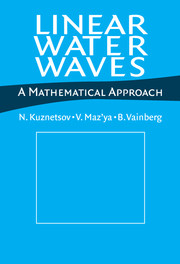Book contents
- Frontmatter
- Contents
- Preface
- Introduction: Basic Theory of Surface Waves
- 1 Time-Harmonic Waves
- 1 Green's Functions
- 2 Submerged Obstacles
- 3 Semisubmerged Bodies, I
- 4 Semisubmerged Bodies, II
- 5 Horizontally Periodic Trapped Waves
- 2 Ship Waves on Calm Water
- 3 Unsteady Waves
- Bibliography
- Name Index
- Subject Index
5 - Horizontally Periodic Trapped Waves
from 1 - Time-Harmonic Waves
Published online by Cambridge University Press: 14 October 2009
- Frontmatter
- Contents
- Preface
- Introduction: Basic Theory of Surface Waves
- 1 Time-Harmonic Waves
- 1 Green's Functions
- 2 Submerged Obstacles
- 3 Semisubmerged Bodies, I
- 4 Semisubmerged Bodies, II
- 5 Horizontally Periodic Trapped Waves
- 2 Ship Waves on Calm Water
- 3 Unsteady Waves
- Bibliography
- Name Index
- Subject Index
Summary
The most well-known trapped mode in the theory of water waves is the simple exponential solution derived by Stokes [313]. It describes a wave over a uniformly sloping beach that can travel unchanged in the direction of the shoreline, and that decays exponentially to zero in the seaward direction. The Stokes edge wave is characterized by being confined to or trapped by the boundary, in this case the beach, despite the fact that the fluid region is unbounded. Little interest was shown in this solution for over a 100 years. Thus Lamb [179], p. 447, states “it does not appear that the type of motion here referred to is very important.” Only in the last forty years or so have further examples of such trapped modes been discovered, and it was recognized that “there is now considerable evidence which indicates that edge waves are common in occurrence and practical use” (see Le Blond and Mysak's book [183], p. 227). Thus the aim of the present chapter is to review many papers representing a considerable progress in the investigation of edge waves and other types of trapped modes that have occurred during the past twenty-five years. The material here is to a great extent borrowed from a survey paper by Evans and Kuznetsov [75], but we also cover new results published since 1995, when that paper was written.
- Type
- Chapter
- Information
- Linear Water WavesA Mathematical Approach, pp. 214 - 262Publisher: Cambridge University PressPrint publication year: 2002



